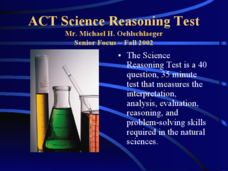Curated OER
Solar and Lunar Eclipses
Young scholars examine eclipses. In this eclipse lesson, students investigate solar and lunar eclipses. Young scholars complete a WebQuest and write a descriptive summary of eclipses. Lesson references a WebQuest, but does not include a...
Curated OER
Tides
Young scholars discover how the position of the Sun, Moon and Earth affect tides. In this science lesson, students view a presentation about the tides. Young scholars discuss the different types of tides.
Curated OER
Planet Interiors
Young scholars compare and contrast the Earth's interior with 2 other planets by looking at images on the computer. For this planet interiors lesson plan, students write a paper about their findings.
Curated OER
Your Weight on Other Planets
Students explore their weight on other planets. For this science lesson, students view a presentation about the other planets and complete a worksheet in which they make predictions about their weight on the moon and other planets.
Curated OER
Scale Model of the Solar System
Students explore the size of the planets. In this science instructional activity, students create a scale model of the solar system. Students determine a scaling factor and calculate the size of their planets. Students create a scale...
Curated OER
Sundials
Students investigate the different types of sundials and their history. In this shadows and time of day lesson students build their own sundials.
Curated OER
Planet Interiors
Students view cut-away images of the planets' interiors, comparing and contrasting them with the Earth's in written form. Students also classify each planet as "terrestrial" or "Jovian". The Planet Interiors applet on the CSA website...
Curated OER
Illustrate the Constellations
Students research ancient Greek heroes immortalized in constellations. They choose three constellations in either the summer or winter sky to illustrate and reinforce their understanding of the northern constellations.
PHET
Pre- and post-assessment (High School)
Need to gauge your pupils' understanding before the lesson begins? A base assessment includes short answer and drawings to determine pupil knowledge. Advanced assessment covers vector addition.
University of Colorado
Looking Inside Planets
Researchers use scientific data to understand what is inside each of the planets. The first in a series of six, this instructional activity builds off of that concept by having pupils use a data table to create their own scale models of...
University of Colorado
Clay Planets
Why do scientists use models? In the first installment of 22, groups create scale models of our solar system. They then share and discuss their models.
University of Colorado
Looking Inside Planets
All of the gas giant's atmospheres consist of hydrogen and helium, the same gases that make up all stars. The third in a series of 22, the activity challenges pupils to make scale models of the interiors of planets in order to...
EngageNY
Choice of Unit
Explore using units with scientific notation to communicate numbers effectively. Individuals choose appropriate units to express numbers in a real-life situation. For this 13th lesson of 15, participants convert numbers in scientific...
Curated OER
Our Home in the Milky Way
Young scholars gain appreciation of the vastness of our galaxy by viewing an applet about the Milky Way. Students hypothesize about how long it would take to get from Earth to Pluto.
Curated OER
A Model of the Sun's interior
Young scholars create a three-dimensional model of the sun. In this solar system activity, students design a scale model of the sun using plasticine.
Curated OER
Red Shift, Blue Shift
Pupils demonstrate how stellar spectra measures a star's motion relative to Earth along the line of sight.
Curated OER
Solar and Lunar Eclipses
Students complete a WebQuest in order to better explain solar and lunar eclipses. They observe images and videos of eclipses from around the world.
Curated OER
The Tides
Students experience a computer based applet that explains why the Earth experiences tides.
Curated OER
Bringing the Solar System Down to Earth
Students develop a scaled down model of the solar system. In small groups, they calculate the scaled-down diameters of the planets and the sun, the scaled-down distance of the planets from the sun, complete two charts, and create a...
Curated OER
Lotto or Life: What Are the Chances?
Though the website does not seem to have the mentioned video, a reding and lottery style games simulate the chances of finding intelligent life somewhere other than Earth. Without the video, this lesson is short, but it can be a useful...
Curated OER
Bubble-ology
Learners observe the visible spectrum while observing light hitting the surface of bubbles. They blow large bubbles and observe how the colors change.
Curated OER
Tasty Constellations
Students conduct research on a constellation and create a model of it using marshmallows as stars. They draw the constellation in pencil on black paper, glue on marshmallows, and trace the pencil with chalk to connect the stars.
Curated OER
Flying with Pythagoras
A lengthy narrative about Pythagoras and his students precedes an activity in which your young mathematicians practice using the Pythagorean theorem to solve three problems about flight and distance. Answers are provided.
Curated OER
ACT Science Reasoning Test
The types of scientific information that need to be analyzed in the ACT test are presented here. Tips and techniques for completing the research, data, viewpoints, and multiple choice questions will help your class and their expectations.
Other popular searches
- Astronomy and Space Science
- Astronomy and Space
- Astronomy/space
- Preschool Astronomy/space
- "Astronomy and Space Science
- Astronomy and Space Lesson

























